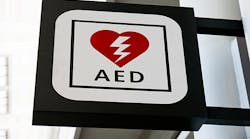Sudden cardiac arrest (SCA) is a leading cause of death and a major health problem in the United States, with more than 356,000 people suffering from out-of-hospital cardiac arrest each year, according to the American Heart Association. Without immediate treatment, death can occur within minutes if the victim collapses, causing nine out of 10 victims of SCA to lose their life (Sudden Cardiac Arrest Foundation).
However, when bystanders intervene by giving CPR and using an automated external defibrillator (AED), survival rates can triple. An AED is a lightweight, portable device that checks a person’s heart and delivers an electric shock if it has stopped beating normally. An AED is the most effective treatment for restoring a regular heart rhythm during SCA. Created with the layperson in mind, these devices are designed to guide the everyday person through a cardiac emergency with simple, step-by-step instructions. An AED can determine if a shock is necessary by analyzing the patient’s heart rhythm and will automatically deliver the right shock, at the right time.
AEDs Through the Years
AEDs have improved immensely from when they were first introduced in 1980s and they have helped drastically change outcomes for people who have suffered a SCA. Before AEDs were available, the first intervention for SCA was cardiopulmonary resuscitation (CPR). While CPR is important, it alone cannot save SCA victims.
When they were first introduced, AEDs weighed 13 pounds and only were used by trained professionals, such as police officers, fire fighters and EMTs. In 1984, the first AED specifically designed to be used by the public was brought to market. At this time, the public at large knew virtually nothing about defibrillators in general and it didn’t cross the publics’ imagination that AEDs would be available in airports, schools, office buildings and even the home.
In the early 1990s, Heartstream, a pioneer in early defibrillation, embarked on a journey to create the small, lightweight, biphasic defibrillator. In the mid-1990s, in response to the availability of public access AEDs, legislatures across the U.S. began putting Good Samaritan legislation in place. While the specifics of these laws vary from state to state, they generally reduce liability risk and assume that when an unconscious victim cannot respond, a Good Samaritan can help them on the grounds of implied consent.
In the early 2000s, AEDs were developed that included attenuated pads for pediatric indications. Shortly thereafter, AEDs were developed that provided guidance for the layperson, acting as a personal coach to guide the user through a cardiac emergency. These AEDs give an untrained responder the confidence to act quickly, decisively and lead the way to save a life.
Today, AEDs are on board major U.S. airlines, dozens of regional airlines and many of the largest international carriers. They also be found in the busiest U.S. airports, professional sports team arenas, shopping malls, casinos and Fortune 500 companies.
The Importance of Training
Despite wide availability, many people still do not know what AEDs are, how to use them or that they are designed to be used by laypeople with no medical background. Contrary to popular belief, trained professionals are not the only people who can help a nearby SCA victim.
Today’s AEDs are designed for the layperson. The more familiar people are with the signs of SCA and the use of the AED, the more likely they are to be calm and helpful in an actual emergency.
Setting up an AED is easy with instructions that guide the user through the set-up process. The entire procedure is complete in just a few minutes and the device is ready to use. AEDs are self-monitoring and perform regular self-tests to make sure that everything is working. Regular maintenance includes periodic replacement of pads and batteries every few years. The device has both audio and visual indicators to alert you of its ready for use state and each AED comes with a sticker reminder system.
AEDs should be placed in visible, accessible and clearly marked location that increase the chances of getting the AED to a person having an SCA in less than three minutes. Elevators, cafeterias and reception areas are all good locations for AEDs.
When bystanders intervene by giving CPR and using AEDs, four out of 10 victims survive (Sudden Cardiac Arrest Foundation). CPR by itself can only extend a victim’s life temporarily, giving the victim a small amount of extra time until an AED is available. Defibrillation is the only treatment option to restore a normal heart rhythm. It is a two-step process to save a SCA victim, with CPR and an AED going hand-in-hand.
Only one-third of SCA victims receive CPR from bystanders, and only 2 percent are treated with AEDs before the paramedics arrive at the scene. For every minute that passes, the chances of survival decrease significantly.
The availability of AEDs in public spaces is crucial and can drastically improve someone’s chances of SCA survival. By driving awareness around AEDs, people will have the understanding of these tools that can empower them with the knowledge and confidence to save a life.
About the Author: Joe Sovak is vice president and general manager, Emergency Care & Resuscitation, Philips. Click here for more information about Philips HeartStart products and survivor stories.
